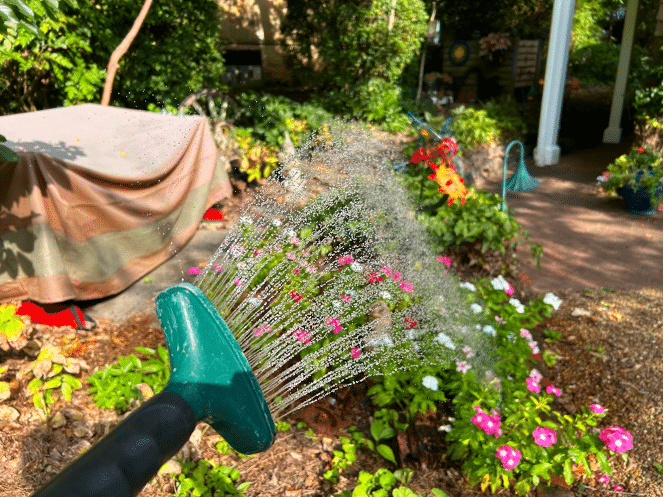A few things to consider when things get dry

Your garden may need some help during our more frequent droughts. How you apply that water matters.
Remember when weather forecasters were relevant? Remember when you could look to the sky and see something other than an orange ball of fire? Remember when people used to read books rather than spend hours with their noses 12” from a phone screen? Whoops! A slight veer there. Now where was I? Remember rain?
I optimistically thought that by writing this I might coax a rain cloud to appear. You know, like washing your car. But alas, the sun still shines a little too brightly for me and the earth continues to bake. If you haven’t yet guessed, today’s post is about water. Or more specifically, how to apply it to help your garden limp into another season. Having taught a course in irrigation design at The University of Tennessee for 20+ years, I know a thing or two about water and gardens. At the beginning I did call in a few professionals to bolster my content. There was kind of a joke amongst these guys about the more unscrupulous, fly-by-night irrigation folks whose motto may have been “just get things wet”. Meaning as long as their clients could arise in the mornings and see that the foliage was wet, all was well.
I want to let you in on a little secret. Ninety percent of all residential irrigation systems are no better than digging a hole, dropping in about $15k, and then covering that money with soil. Why? Nearly all systems are NOT maintained just a few years after installation. Plants grow and block water delivery, turf and planting bed zones are not separated properly, and the biggest sin of all (in my opinion) is that these systems operate at a water pressure that is too high.
Next time your see an irrigation system running, look just above the spray and notice that pretty little mist rolling toward the heavens. This is called “atomizing” of the water droplets. In a nutshell, the water droplets coming out of the heads are being broken up by the high pressure and evaporating before they ever make contact with the plants or lawn. What a waste of our earth’s most precious resource!

A system running at too high pressure. Notice the small droplets going up, up, and away!
Okay. So, you don’t have an irrigation system and everything is hunky dory when you water by hand. Right? Wrong! So many gardeners dragging those hoses around are watering inefficiently. The first “wrong” is using a spray nozzle. You know, the same kind you use to blast crap out of your gutters. These are great for washing your car but terrible for watering. It’s unlikely that your very thirsty hydrangea has asked to be power washed. The best approach to hand watering is to use a gentle water wand that doesn’t increase the water velocity or go nozzle-free. Use this approach and be patient (I know. Who has time to water like this?) Watering slowly allows the water to be absorbed into the soil rather than just run off.
Try this. For larger shrubs and trees, set a timer, turn on the faucet minimally, place the nozzle on the ground and go do other things. BUT… set that timer for 5 or 6 minutes AND keep it with you. Use your judgment for how much you should move the nozzle around to hit other parts of the plant’s root zone. For thirsty annuals and perennials, be patient and apply water to the general area and repeat a couple of times. Again, allowing water to percolate through the soil rather than run off.

We have one of these Orbit fan nozzles near each of our water hoses all summer.
TIME OF DAY
Earlier is better. When you water in the morning your plants and their foliage will get time throughout the day to dry before nightfall. Watering late evening may encourage some fungal problems. I won’t go into details here because as you may have gathered, I don’t really know everything!
MULCH
Yep. It’s critical to hold soil moisture. I’ve written about mulch before and those who follow me know that I’m partial to chopped-up leaf mulch and/or pine straw. To those folks who love “changing the brown” with shredded hardwood bark mulch, go easy. If this material is not allowed to decompose somewhat, it will actually act as a barrier and turn water AWAY from your plants’ root zones. The point is a nice layer of mulch as opposed to bare soil is much better, allowing moisture to be available longer for your plants.
RAIN BARRELS AND RAIN GARDENS
I will be posting a separate writing pertaining to rain gardens and rain barrels so stay tuned!
That’s it! Hopefully, rain will once again fall from the sky but until then think big water droplets and watering patience.
Please share and subscribe! https://ahomeforyourgnome.com/
LASTLY, I plan to keep posting every Monday for the rest of the year but who knows after that? It’s very hard to tell if anyone is reading these. As an incentive for any help spreading the word about my site, I would like to send a free copy of my new book, A Home for Your Gnome to whoever gets me the most new subscribers! So tell your friends and share the link. Also, please contact me through this email to let me know who you’ve convinced to subscribe. I’ll tally up all new referrals at the end of this month and contact a lucky winner! Feel free to contact me to tell me to keep writing or share any thoughts.
THANKS as always!

